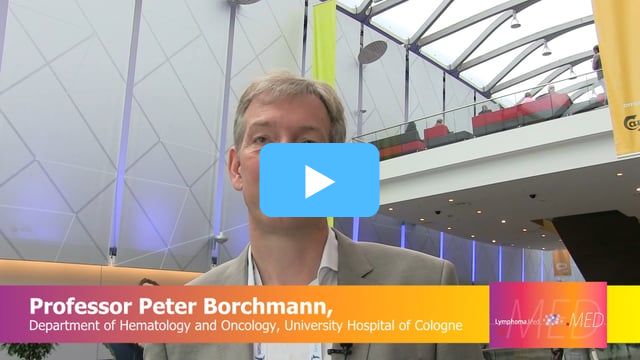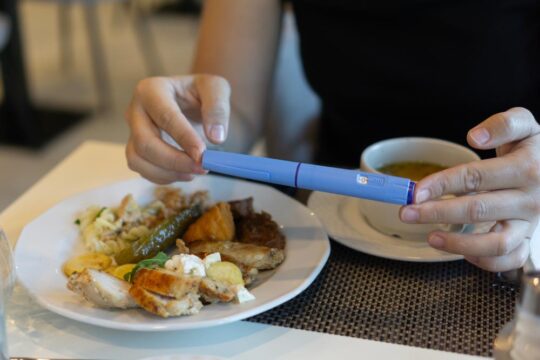Advertisment
Updated findings from the German Hodgkin Study Group HD18 trial

BEACOPP treatment offers considerable advantages in terms of overall survival and low dose regimens offer short, safe and effective treatment for newly-diagnosed advanced-stage HL patients ……
Article by Christine Clark. Interview by Esther Drain.
Professor Peter Borchmann (Cologne) discusses the updates he presented on the HD18 study.
Escalated BEACOPP (eBEACOPP; bleomycin, etoposide, doxorubicin, cyclophosphamide, Oncovin (vincristine), procarbazine, prednisolone) treatment for advanced stage Hodgkin lymphoma (HL) results in better survival than ABVD (doxorubicin, bleomycin, vinblastine and dacarbazine) – the five-year overall survival (OS) difference is 10% (95% CI: 13%–5%), Professor Peter Borchmann (Cologne) told the audience. However, about 70% of patients with advanced stage HL can be cured with ABVD alone. The current international prognostic score does not discriminate between the low risk and high-risk patients. For this reason, the German Hodgkin Study Group (GHSG) HD18 trial was designed to examine the impact of early interim PET-guided therapy using eBEACOPP in advanced stage HL.
After two cycles of eBEACOPP FDG PET/CT scans were performed and reviewed centrally. PET-positive patients received either six cycles of eBEACOPP or one cycle of eBEACOPP followed by 5 cycles of rituximab/eBEACOPP (arms A and B of the trial). PET-negative patients received either six cycles of eBEACOPP or two cycles of eBEACOPP (arms C and D of the trial). Patients with residual disease who were PET-positive at the end of the trial were offered radiotherapy. The trial used a conservative definition of PET negativity and was designed to show non-inferiority (a five-year PFS difference ≥ 6%). The design was amended during the trial to reduce the dose of eBEACOPP to six cycles, based on the results of HD15 trial that showed six cycles were as effective as eight.
Just over one thousand (1005) PET-negative patients were randomised to arms C and D. The five-year progression-free survival (PFS) showed no difference between six-eight cycles of eBEACOPP (91.2% (95% CI: 88.5–94.0) and four cycles of eBEACOPP (91.8 (95% CI: 89.0–94.6) (difference +0.6% (95% CI: -3.3 – +4.5); HR 0.88 (95% CI: 0.57- 1.36)). Moreover, treatment related morbidity (grade III/IV organ toxicity, anaemia, thrombopaenia or infection) occurred in more than 60% of patients receiving six-eight cycles compared with 41% of those receiving four cycles. Toxicity commonly occurred with later doses, Professor Borchmann noted. In addition, the incidence of second neoplasia and death due to the toxicity of treatment was higher with six-eight cycles of chemotherapy.
This trial showed that four cycles of eBEACOPP was non-inferior to six-eight cycles with a PFS of 92% at five years and the lower-dose regimen was associated with less toxicity, fatigue and mortality. Professor Borchmann concluded that this regimen is safe, short and affordable and these are features that are important for young patients.
Turning to the PET-positive arms (A and B) of the HD18 trial, Professor Borchmann explained that it had been designed on the basis that the three-year PFS for this group was less than 70% and that the addition of rituximab might improve PFS. In fact, the results showed that in this group of patients the three-year PFS after eight cycles of eBEACOPP alone was already 93% and so there was limited room for improvement. A re-examination of the PFS according to the Deauville score showed that a score of 4 clearly separated those at risk of early progression and relapse, whereas using a cut-off point of Deauville score 3-4 did not. A Deauville score (DS) of 4, reached by 25% of patients, was associated with a three-year PFS of 87.6% (95% CI: 83.0–92.3%) whereas scores of 1–3, reached by 75% of patients, were associated with three-year PFS 94.2% (95% CI: 92.0–96.5%), a difference of -6.6% (95% CI: -11.8 to -1.4%); hazard ratio 2.27 (95% CI 1.35–3.84; p= 0.002).
In summary, only a DS of 4 after two cycles of eBEACOPP indicated a risk of early treatment failure with GHSG standard treatment and inferior PFS and OS – but still at a high level. The researchers concluded that a DS of 4 after two cycles of eBEACOPP allows identification of patients who will benefit from intensive treatment with six cycles of eBEACOPP and this has become the standard of care in the GSHG. A DS of 1–3 after two cycles of eBEACOPP has a high negative predictive value and can identify patients who will benefit from very short, safe and effective treatment.
Professor Borchmann concluded that the balance of risks and benefits of using eBEACOPP in a PET-2 guided strategy makes it an attractive option for newly-diagnosed, advanced stage HL patients.
Based on presentations given at the British Society of Haematology 58th Annual Scientific Meeting, Liverpool, UK.





